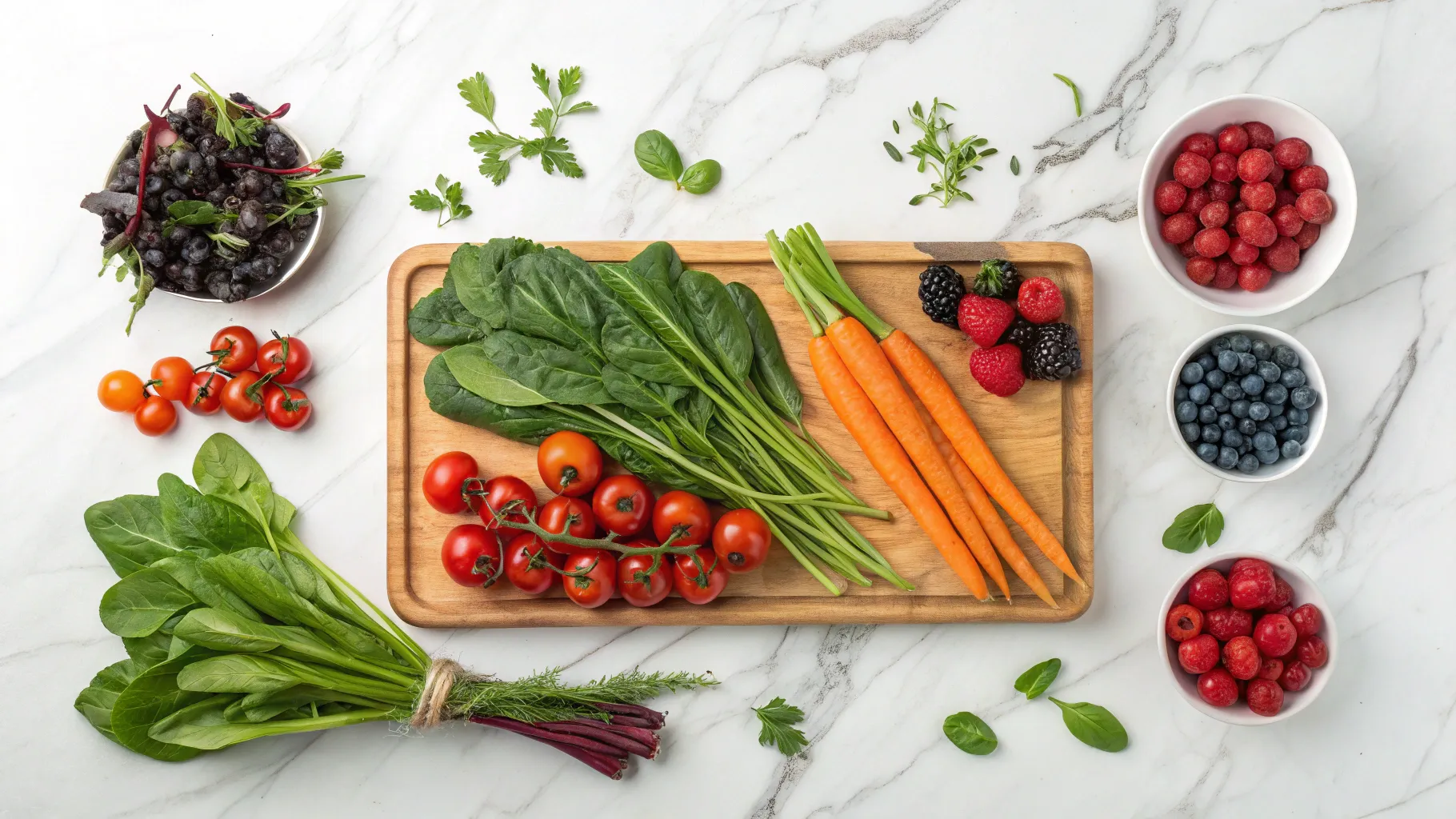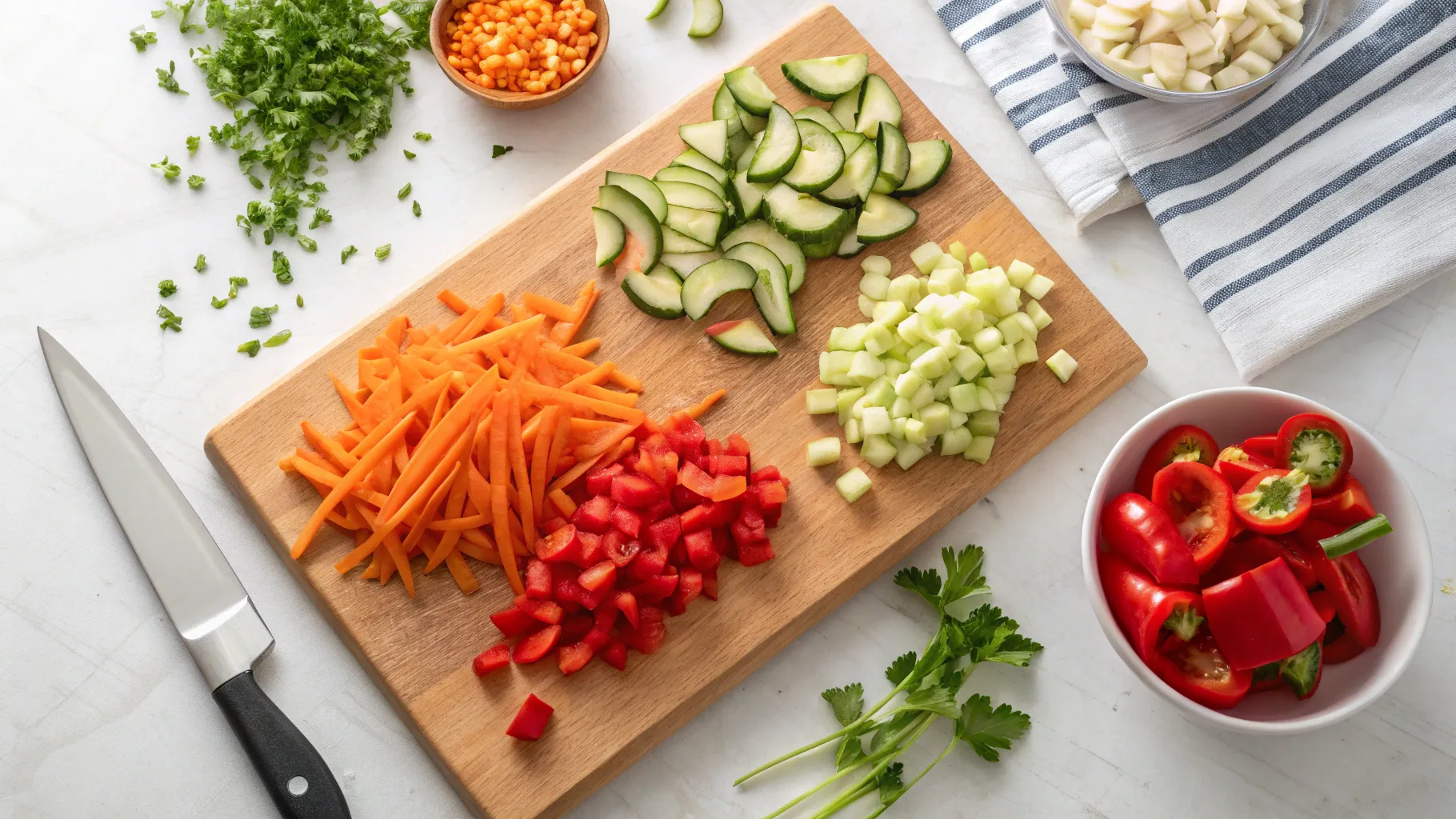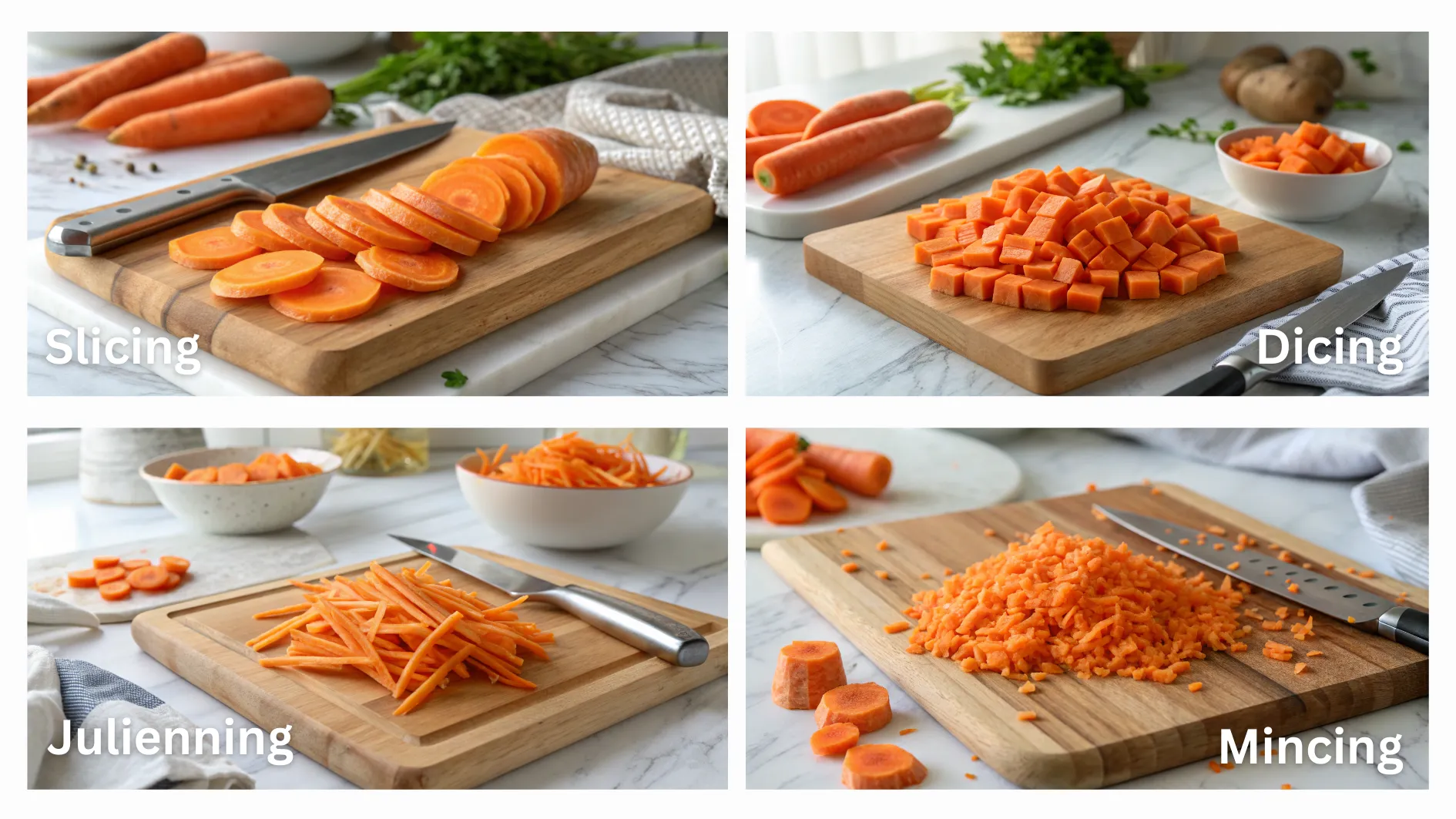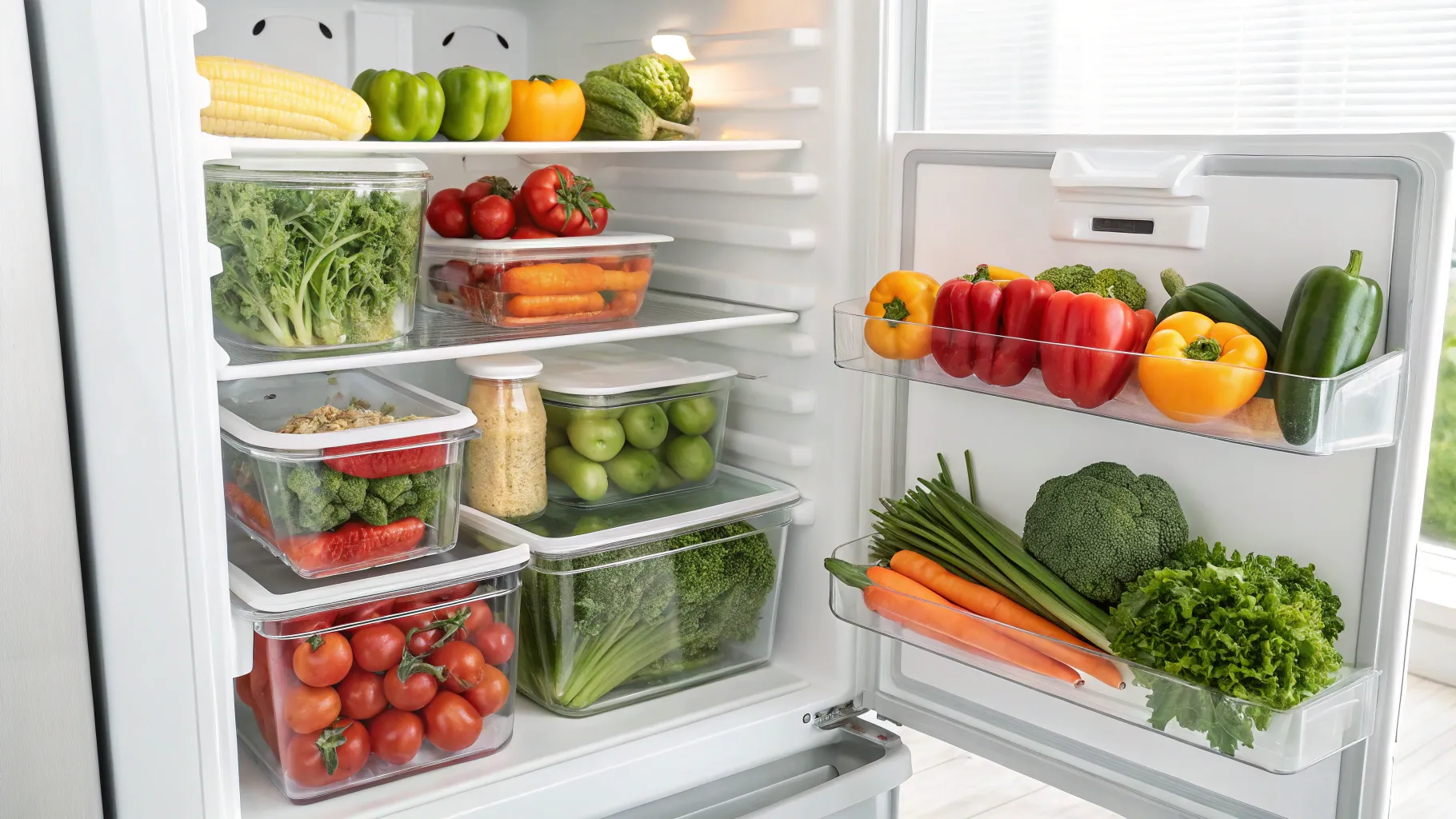Mastering the basics of vegetable prep is essential for every home cook. Whether you’re just starting out in the kitchen or looking to sharpen your skills, learning how to properly wash, peel, and chop vegetables can greatly improve your cooking. These foundational techniques not only influence the flavor and appearance of your dishes but also play a vital role in food safety and overall kitchen efficiency.
If you’re new to prepping produce or want to improve your efficiency in the kitchen, mastering vegetable prep is a game-changer. Before diving into chopping and peeling, it helps to stock your pantry with the right tools. Check out our ultimate guide to essential kitchen tools to make your setup stress-free. And if you’re wondering how these techniques tie into flavor, don’t miss The Beginner’s Guide to Spices to discover how fresh vegetables and spices work hand-in-hand.
In this in-depth guide, you’ll discover practical vegetable prep methods, expert tips, and smart storage strategies to help you handle produce like a pro.
Washing: The First Step to Safe and Delicious Vegetables
Before you chop, peel, or cook, washing your vegetables is an essential step in proper vegetable prep that should never be skipped. Whether your produce is conventionally grown, organic, or straight from the garden, it can carry dirt, bacteria, pesticides, or waxes on the surface. Even if you plan to peel the vegetable, washing it first ensures you’re not dragging any of those unwanted residues into the part you’re about to eat.
Clean vegetables not only protect your health, but also improve flavor and texture. Grit left on leafy greens can ruin a salad, and unwashed root vegetables can add bitterness or mud-like flavors to your dish, reminding us that effective vegetable prep makes all the difference in cooking.
1. How to Wash Vegetables Properly:
-
Use cool running water:
Rinse each item individually under cold or room-temperature running water. Do not use soap, bleach, or other cleaning agents, these can leave harmful chemical residues and aren’t safe for consumption. -
Scrub firm vegetables:
Use a clean, dedicated vegetable brush to scrub rough-skinned produce like potatoes, carrots, turnips, and beets. This removes stubborn dirt and helps you avoid peeling, preserving nutrients found just under the skin. -
Handle leafy greens with care:
Greens like spinach, kale, and lettuce can trap dirt and sand between leaves. Separate them, soak in a bowl of cold water, swish gently, then lift out (don’t pour out — sediment will settle at the bottom). Dry thoroughly with a clean towel or in a salad spinner. -
Soak to loosen debris:
Vegetables with tight crevices or florets, such as broccoli, cauliflower, or leeks, may need a short soak to remove hidden grit. Fill a bowl with cold water, submerge the vegetable, and let it sit for 1–2 minutes before rinsing under running water. -
Dry thoroughly before storing or cooking:
Excess moisture can lead to sogginess during cooking or encourage mold and decay if storing. Pat dry with a clean kitchen towel or paper towels, or use a spinner for leafy greens.
Washing vegetables may feel like a small step, but it’s one of the most impactful parts of vegetable prep. It lays the foundation for a clean, crisp, and safe meal, while also building a solid habit that supports confident cooking.

Peeling: When and How to Do It Right
Peeling is one of the most common vegetable prep tasks, but it isn’t always required. In fact, many vegetable peels are perfectly edible and packed with nutrients like fiber, potassium, and antioxidants. However, there are times when peeling improves the texture, removes bitterness, or simply makes a dish more enjoyable to eat.
Learning when to peel and how to do it safely is a key part of smart vegetable prep, it can save you time, reduce waste, and help you create better meals.
When to Peel:
-
Vegetables with thick, fibrous, or tough skins
Examples include winter squash, rutabagas, turnips, and kohlrabi, which often have hard or chewy outer layers that don’t break down well during cooking. -
When a smooth texture is essential
For dishes like mashed potatoes, creamy soups, or baby food, peels can interfere with the final texture and mouthfeel. -
When vegetables are waxed or heavily treated
Many supermarket cucumbers, apples, or eggplants are coated in food-safe wax to preserve freshness, but this can affect taste or digestion. Peeling removes that layer entirely. -
When skins are damaged or blemished
Peeling is a great way to eliminate bad spots and reduce bitterness from overripe or scarred skins.
Peeling Tips for Speed and Safety:
-
Use the right tool for the job
A sharp Y-peeler or swivel-style peeler is best for thin-skinned vegetables like carrots, zucchini, or cucumbers.
Use a paring knife for thick-skinned produce such as butternut squash, sweet potatoes, or to dig out potato eyes or blemishes. -
Peel away from your body
Always peel in a direction that keeps your fingers out of the path of the blade. Consider peeling downward onto a cutting board if you’re just starting out. -
Create a clean workstation
Peel over a trash bowl, compost bin, or cutting board to keep peels contained and your counters clean. Some home cooks keep a “scrap bowl” on the counter to collect peels and scraps for composting or broth-making. -
Grip for control
Hold the vegetable firmly with one hand and your peeler or knife with the other. If the vegetable is rolling, slice a thin edge off one side to create a flat base before peeling.
Should You Always Peel?
Not at all! In fact, skipping the peel can often be a healthier and more efficient option.
Vegetables like:
- Young carrots
- Zucchini
- Thin-skinned potatoes
- Eggplant
- Cucumbers (especially unwaxed varieties)
…can usually be cooked and eaten with the skin on. Their skins add texture, color, and nutrients, and help reduce prep time and food waste.
Just remember: if you’re leaving the skin on, make sure you wash thoroughly before cooking, especially for root vegetables. Proper cleaning is a crucial step in vegetable prep to ensure safety and flavor.
Peeling may seem simple, but knowing when and how to do it properly can elevate your meals and streamline your kitchen workflow. Think of peeling as a flexible part of vegetable prep, not a strict rule, and let your recipe, texture, and taste preferences guide you.

Chopping: Basic Knife Skills for Every Cook
Chopping vegetables is more than just a prep step, it’s a foundational skill in vegetable prep that shapes the outcome of nearly every dish you cook. Well-chopped vegetables look more appealing, cook more evenly, and help create a balanced texture in your meals. Whether you’re prepping a colorful stir-fry or a hearty soup, mastering this part of vegetable prep ensures faster cooking and more consistent results.
And the best part? You don’t need to be a chef to develop solid knife skills. With a bit of practice and the right techniques, you’ll be slicing and dicing like a pro in no time.
Knife Safety & Setup
Before you even start chopping, setting yourself up properly makes a big difference, both for your safety and your efficiency.
-
Use a sharp knife:
It may sound counterintuitive, but a sharp knife is much safer than a dull one. Dull blades require more pressure, which makes them more likely to slip and cause injury. -
Stabilize your cutting board:
To prevent slipping, place a damp kitchen towel or non-slip mat under your board. This provides stability and keeps your workspace secure. -
Use the claw grip:
Curl your fingertips inward like a claw, keeping them away from the blade. Your knuckles act as a guide for the knife, helping you maintain control and avoid accidents. -
Choose the right knife:
A chef’s knife (8–10 inches) is great for most tasks. Use a paring knife for smaller, more detailed cuts, and a serrated knife for soft foods like tomatoes or bread.

Common Cutting Techniques
Mastering a few basic cuts will make prep more consistent and enjoyable:
-
Slicing:
Thin, uniform cuts typically used for items like onions, cucumbers, zucchini, or mushrooms. Great for stir-fries, salads, and sandwiches. -
Dicing:
Cutting into small, even cubes. This is especially useful for potatoes, carrots, peppers, or celery, perfect for soups, stews, and sautés. -
Julienning:
Thin, matchstick-like strips often used for carrots, bell peppers, or zucchini in stir-fries and raw veggie salads. A mandoline can help if you want precision. -
Chopping:
A more rustic, rougher cut ideal for herbs, greens, or vegetables in casual or homey dishes. Often used in soups, casseroles, and braises where perfect uniformity isn’t required. -
Mincing:
The finest cut, used to break down ingredients like garlic, shallots, or herbs into very small pieces. Helps flavor distribute more evenly in a dish.
Bonus: Tips for Faster, Cleaner Chopping
- Use a bench scraper to transfer chopped ingredients from board to bowl or pan without dulling your knife on the board’s surface.
- Keep your cutting board clean by wiping away scraps and juices between tasks, this keeps flavors from mixing and avoids clutter.
- Organize your chopped items into prep bowls (mise en place) so you’re ready to cook without pause.
Learning how to chop vegetables efficiently is one of the best ways to boost your confidence and enjoyment in the kitchen. With proper form, sharp tools, and a little bit of practice, you’ll move from vegetable prep to plate faster, and with better results. Keep practicing your cuts, and soon, chopping veggies will feel like second nature, making vegetable prep a smooth and rewarding part of your cooking routine.
 Storage: Keeping Prepped Vegetables Fresh and Safe
Storage: Keeping Prepped Vegetables Fresh and Safe
After putting time and care into washing, peeling, and chopping your vegetables, the last thing you want is for them to spoil before you use them. Proper storage is the final step in smart vegetable prep, helping preserve freshness, texture, and nutrients while also cutting down on food waste and saving time during the week.
Whether you’re meal prepping or simply trying to make your vegetables last longer, mastering this part of vegetable prep ensures you get the most out of your produce every time.
1. Storage Guidelines to Follow
Store in Airtight Containers
Place prepped vegetables in airtight containers and refrigerate them promptly. This protects them from drying out, absorbing odors, or getting contaminated.
- Glass containers are excellent because they don’t retain odors or stains.
- BPA-free plastic containers or reusable silicone bags also work well.
Use Paper Towels to Control Moisture
Moisture is the enemy of crisp vegetables.
- Line containers with a dry paper towel before adding prepped vegetables.
- The towel absorbs excess moisture, which helps prevent wilting and spoilage, especially for leafy greens and chopped herbs.
Separate Ethylene Producers
Some fruits and vegetables emit ethylene gas, which speeds up ripening (and spoiling).
- Keep items like tomatoes, bananas, and avocados away from ethylene-sensitive produce like lettuce, spinach, or fresh herbs.
- This small adjustment can extend shelf life and keep your veggies looking and tasting fresh longer.
Label and Date Everything
Keep track of your vegetable prep by labeling containers with the date and contents.
- This helps you prioritize what needs to be used first and prevents forgotten containers from becoming mystery science experiments.
- Use masking tape and a marker or write directly on reusable containers with a dry-erase pen.
2. How Long Do Prepped Vegetables Last in the Fridge?
Prepped vegetables have different shelf lives depending on how they’re stored:
- Sliced carrots last about 5 to 7 days.
- Sliced bell peppers stay fresh for 3 to 4 days.
- Broccoli and cauliflower keep for around 3 to 5 days.
- Leafy greens last 3 to 5 days, especially when stored with a paper towel to absorb excess moisture.
- Chopped onions have a longer shelf life of 7 to 10 days.
- Raw cut potatoes should be kept in water and used within 1 to 2 days.
Bonus Storage Tips:
- Store cut potatoes and other starchy vegetables in cold water in the fridge to prevent browning, but be sure to use them within a day or two and dry thoroughly before cooking.
- Freeze extras: If you’ve prepped too much, consider freezing hearty vegetables like chopped carrots, onions, and bell peppers. Blanching them before freezing preserves color and texture.
- Don’t overpack containers: Allow a little space for airflow to help maintain freshness.
Keeping your vegetables fresh isn’t just about preserving their lifespan, it’s about making vegetable prep more efficient, organized, and enjoyable. With a few simple practices, you’ll reduce waste, cook faster, and always have healthy ingredients at your fingertips.

Quick Reference: Common Vegetables and Prep Suggestions
| Vegetable | Wash | Peel | Chop Style |
|---|---|---|---|
| Carrots | Yes | Optional | Sliced, diced, julienne |
| Potatoes | Yes | Optional | Cubed, wedges |
| Onions | Yes | Yes | Diced, sliced |
| Zucchini | Yes | No | Sliced, half moons |
| Bell Peppers | Yes | No | Strips, diced |
| Spinach/Kale | Yes | No | Rough chop |
| Broccoli/Cauliflower | Yes | No | Florets |
Bonus Tips for Faster and Smarter Prep
- Batch prep your vegetables once or twice a week to save time on busy days.
- Use a bench scraper to move chopped veggies into bowls or pans without dulling your knife.
- Invest in quality tools like a mandoline, garlic press, or salad spinner to reduce prep time.
- Keep your knives sharp, sharpen at home with a whetstone or take them to a professional every few months.
FAQs: Common Vegetable Prep Questions
Q1: Can I wash vegetables ahead of time and store them?
Yes, but only if they’re completely dried and stored properly. Moisture leads to spoilage, so in smart vegetable prep, always use paper towels and airtight containers to extend freshness.
Q2: What’s the safest way to cut round vegetables like onions or potatoes?
In vegetable prep, safety comes first. Always create a flat surface by slicing the vegetable in half before cutting. Place the flat side down for stability, which makes chopping smoother and safer.
Q3: Do I need to peel carrots or potatoes before roasting?
Not always! In many cases, vegetable prep is about choice, not rules. As long as they’re washed thoroughly, the skin adds flavor, texture, and extra fiber, making your meals healthier and easier to prepare.
Q4: Can I freeze prepped vegetables?
Yes! Freezing is an excellent vegetable prep strategy. Many vegetables freeze well once chopped, but blanching them first helps preserve texture, color, and nutrients for longer storage.
Q5: What’s the best way to prep leafy greens?
For proper vegetable prep, rinse greens thoroughly, spin dry, and store them in a breathable container lined with paper towels. This keeps them crisp for several days and ready to use in salads, sautés, or smoothies.
Final Thoughts: Confidence Starts with Preparation
Vegetable prep doesn’t have to be time-consuming or intimidating. By learning how to wash, peel, and chop efficiently, you not only make cooking easier, you also boost your confidence and enjoyment in the kitchen.
Keep practicing the basics, invest in the right tools, and soon vegetable prep will become second nature. Whether you’re sautéing, roasting, or tossing together a salad, well-prepared vegetables are the foundation of every flavorful, nutritious meal.
Ready to slice like a pro? Grab your board, sharpen your knife, and start chopping!
💡 Enjoyed this post?
Follow us for daily kitchen tips and tasty inspiration!
📌 Pinterest | 📘 Facebook | 📸 Instagram


